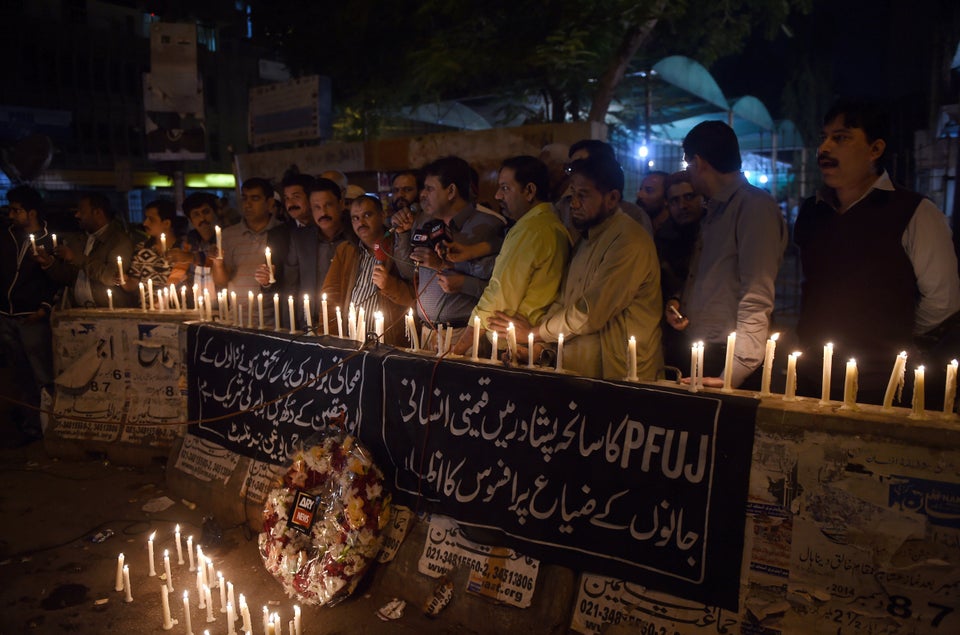
ISLAMABAD -- It is unthinkable that there should have to be a plan to make a school safe. It is even more heartbreaking that the plan has 15 critical points, each of them potentially lifesaving, and it will cost tens, maybe hundreds of millions of dollars, to fully implement.
I have almost stopped asking: Why?
In the past few years, in my role as education envoy, I have seen schools and classrooms abused by both terrorists and militarists. How absurd that a building which is a haven and place of learning and opportunity can at the same time be a blunt and powerful weapon in different hands.
No parent should have to watch their girls and boys step behind the gates of a school where the walls have to be eight feet high and covered in razor wire, while watchers' eyes scan the crowd for signs of a gunman or bomber.
This is now reality in parts of Pakistan. On Dec. 16 -- two months ago -- an event united the world in outrage once again. One hundred and thirty-two children dead. Murdered by the Taliban in classrooms and corridors. This horrific attack in Peshawar, the worst school atrocity ever, was on boys and girls everywhere and has led us quickly back to an initiative launched in Nigeria last year -- Safe Schools. The move came after the terrorist group Boko Haram abducted 276 schoolgirls in Chibok last April.
A fund has so far mobilized $30 million.
The initiative focuses on school and community interventions, with special measures for the most at-risk and vulnerable children. It aims to build better school fortifications, link schools to police stations by mobile telecommunications and create community security groups promoting safe zones for education consisting of teachers, parents, police, community leaders and young people themselves.
So now we don't ask "why" but we must try to answer "how" and "when." How can we make schools safe and when can it happen? Today I have helped launch a 15-point best practices plan for Pakistan, built around global experience and expertise and designed to ensure schools there are safe for all children.
Prime Minister Nawaz Sharif and I have spoken extensively, and we agree that every effort should be made to keep schools safe and open for girls and boys and to not interrupt their education. He has declared he wants the initiative to be "a success." Businesses, foundations and aid agencies are being asked to support safe schools in Pakistan.
The new proposal includes:
-- Community engagement to establish peace zones in and around schools
-- Negotiations with religious leaders to promote education
-- Establishing a community watch
-- Setting up of rapid response units
-- Installing state-of-the-art communication systems
Each of those steps can make children and their parents less afraid to pursue education.
The Pakistani government has already taken steps to implement some security measures in several provinces. For example, following the December attack, the Punjab government released a set of requirements for schools which included installing closed-circuit cameras, raising boundary walls of schools to at least eight feet and topping them with razor wire. These requirements were to be met before schools reopened after the winter break. But in January, only 118 of 1,440 schools in Peshawar had properly implemented the new measures necessary to officially reopen. Additional financing is urgently needed for full implementation of the Safe Schools plan, particularly for communities most at risk.
In the two years since the Taliban's school bus shooting of Malala Yousafzai in Swat Valley, I have had to send too many letters of condolence to families of girls and boys murdered in classrooms. The list is tragic -- Afghanistan, Yemen, Syria, Gaza, every region of Pakistan from Sindh to Balochistan and KPK , and most recently, Nigeria, where Boko Haram has wreaked havoc, shooting nearly 200 teachers and hundreds more pupils.
It is now time to take action. The new initiative is part of an effort to create a Safe Schools movement from Pakistan and Nigeria to the Democratic Republic of the Congo, Afghanistan and beyond, where education for girls and boys must be safeguarded and protected.
A human rights report released last week shows that schoolgirls were particularly vulnerable to attack. Girls and boys have faced nearly 10,000 individual attacks on their educational institutions in the past five years, including murder, arson, kidnapping and intimidation against girls simply for wanting to go to school. In 2012 alone there were 3,600 separate attacks against educational institutions, teachers and schools.
And across the world we should be taking even more action. Schools that already have the same legal rights under international law as hospitals should also be the subject of agreements that they never become instruments of war. They should be as safe as the hospitals that have red crosses on them and the UN buildings and vehicles that bear the UN blue symbol.
The perpetrators of terrorist crimes against children should be made aware that murdering or abducting schoolchildren is a heinous crime that international authorities will punish. Even in the world's most dangerous places we must now establish the right of all children to schooling and make a new idea of "education without borders" a reality.
And while we cannot end terrorism overnight, we can show determination to stand up to it by making schools safe and defending every girl's and boy's right to education and to a life.

